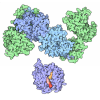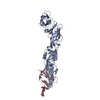[English] 日本語
 Yorodumi
Yorodumi- PDB-3ixy: The pseudo-atomic structure of dengue immature virus in complex w... -
+ Open data
Open data
- Basic information
Basic information
| Entry | Database: PDB / ID: 3ixy | ||||||
|---|---|---|---|---|---|---|---|
| Title | The pseudo-atomic structure of dengue immature virus in complex with Fab fragments of the anti-fusion loop antibody E53 | ||||||
 Components Components |
| ||||||
 Keywords Keywords |  VIRUS / VIRUS /  Dengue Virus / DENV / immature / fusion loop / Dengue Virus / DENV / immature / fusion loop /  Fab / E53 / ATP-binding / Fab / E53 / ATP-binding /  Envelope protein / Envelope protein /  Helicase / Helicase /  Hydrolase / Hydrolase /  Membrane / Nucleotide-binding / Membrane / Nucleotide-binding /  RNA replication / RNA replication /  Transmembrane / Transmembrane /  Virion / Virion /  Capsid protein / Cleavage on pair of basic residues / Capsid protein / Cleavage on pair of basic residues /  Core protein / Core protein /  Endoplasmic reticulum / Endoplasmic reticulum /  Glycoprotein / Glycoprotein /  Secreted Secreted | ||||||
| Function / homology |  Function and homology information Function and homology information : / symbiont-mediated suppression of host JAK-STAT cascade via inhibition of host TYK2 activity / host cell mitochondrion / : / symbiont-mediated suppression of host JAK-STAT cascade via inhibition of host TYK2 activity / host cell mitochondrion /  flavivirin / symbiont-mediated suppression of host JAK-STAT cascade via inhibition of STAT2 activity / symbiont-mediated suppression of host cytoplasmic pattern recognition receptor signaling pathway via inhibition of MAVS activity / ribonucleoside triphosphate phosphatase activity / : / flavivirin / symbiont-mediated suppression of host JAK-STAT cascade via inhibition of STAT2 activity / symbiont-mediated suppression of host cytoplasmic pattern recognition receptor signaling pathway via inhibition of MAVS activity / ribonucleoside triphosphate phosphatase activity / : /  viral capsid / nucleoside-triphosphate phosphatase ... viral capsid / nucleoside-triphosphate phosphatase ... : / symbiont-mediated suppression of host JAK-STAT cascade via inhibition of host TYK2 activity / host cell mitochondrion / : / symbiont-mediated suppression of host JAK-STAT cascade via inhibition of host TYK2 activity / host cell mitochondrion /  flavivirin / symbiont-mediated suppression of host JAK-STAT cascade via inhibition of STAT2 activity / symbiont-mediated suppression of host cytoplasmic pattern recognition receptor signaling pathway via inhibition of MAVS activity / ribonucleoside triphosphate phosphatase activity / : / flavivirin / symbiont-mediated suppression of host JAK-STAT cascade via inhibition of STAT2 activity / symbiont-mediated suppression of host cytoplasmic pattern recognition receptor signaling pathway via inhibition of MAVS activity / ribonucleoside triphosphate phosphatase activity / : /  viral capsid / nucleoside-triphosphate phosphatase / viral capsid / nucleoside-triphosphate phosphatase /  double-stranded RNA binding / protein complex oligomerization / monoatomic ion channel activity / mRNA (guanine-N7)-methyltransferase / methyltransferase cap1 / clathrin-dependent endocytosis of virus by host cell / viral nucleocapsid / double-stranded RNA binding / protein complex oligomerization / monoatomic ion channel activity / mRNA (guanine-N7)-methyltransferase / methyltransferase cap1 / clathrin-dependent endocytosis of virus by host cell / viral nucleocapsid /  mRNA (nucleoside-2'-O-)-methyltransferase activity / mRNA 5'-cap (guanine-N7-)-methyltransferase activity / mRNA (nucleoside-2'-O-)-methyltransferase activity / mRNA 5'-cap (guanine-N7-)-methyltransferase activity /  RNA helicase activity / host cell endoplasmic reticulum membrane / membrane => GO:0016020 / host cell perinuclear region of cytoplasm / RNA helicase activity / host cell endoplasmic reticulum membrane / membrane => GO:0016020 / host cell perinuclear region of cytoplasm /  protein dimerization activity / protein dimerization activity /  RNA helicase / induction by virus of host autophagy / RNA helicase / induction by virus of host autophagy /  RNA-directed RNA polymerase / viral RNA genome replication / RNA-directed RNA polymerase / viral RNA genome replication /  RNA-dependent RNA polymerase activity / serine-type endopeptidase activity / fusion of virus membrane with host endosome membrane / RNA-dependent RNA polymerase activity / serine-type endopeptidase activity / fusion of virus membrane with host endosome membrane /  viral envelope / symbiont-mediated suppression of host type I interferon-mediated signaling pathway / host cell nucleus / structural molecule activity / virion attachment to host cell / virion membrane / viral envelope / symbiont-mediated suppression of host type I interferon-mediated signaling pathway / host cell nucleus / structural molecule activity / virion attachment to host cell / virion membrane /  proteolysis / extracellular region / proteolysis / extracellular region /  ATP binding / ATP binding /  membrane / membrane /  metal ion binding metal ion bindingSimilarity search - Function | ||||||
| Biological species |   Dengue virus 2 Dengue virus 2  Mus musculus (house mouse) Mus musculus (house mouse) | ||||||
| Method |  ELECTRON MICROSCOPY / ELECTRON MICROSCOPY /  single particle reconstruction / single particle reconstruction /  cryo EM / Resolution: 23 Å cryo EM / Resolution: 23 Å | ||||||
 Authors Authors | Cherrier, M.V. / Kaufmann, B. / Nybakken, G.E. / Lok, S.M. / Warren, J.T. / Nelson, C.A. / Kostyuchenko, V.A. / Holdaway, H.A. / Chipman, P.R. / Kuhn, R.J. ...Cherrier, M.V. / Kaufmann, B. / Nybakken, G.E. / Lok, S.M. / Warren, J.T. / Nelson, C.A. / Kostyuchenko, V.A. / Holdaway, H.A. / Chipman, P.R. / Kuhn, R.J. / Diamond, M.S. / Rossmann, M.G. / Fremont, D.H. | ||||||
 Citation Citation |  Journal: EMBO J / Year: 2009 Journal: EMBO J / Year: 2009Title: Structural basis for the preferential recognition of immature flaviviruses by a fusion-loop antibody. Authors: Mickaël V Cherrier / Bärbel Kaufmann / Grant E Nybakken / Shee-Mei Lok / Julia T Warren / Beverly R Chen / Christopher A Nelson / Victor A Kostyuchenko / Heather A Holdaway / Paul R ...Authors: Mickaël V Cherrier / Bärbel Kaufmann / Grant E Nybakken / Shee-Mei Lok / Julia T Warren / Beverly R Chen / Christopher A Nelson / Victor A Kostyuchenko / Heather A Holdaway / Paul R Chipman / Richard J Kuhn / Michael S Diamond / Michael G Rossmann / Daved H Fremont /  Abstract: Flaviviruses are a group of human pathogens causing severe encephalitic or hemorrhagic diseases that include West Nile, dengue and yellow fever viruses. Here, using X-ray crystallography we have ...Flaviviruses are a group of human pathogens causing severe encephalitic or hemorrhagic diseases that include West Nile, dengue and yellow fever viruses. Here, using X-ray crystallography we have defined the structure of the flavivirus cross-reactive antibody E53 that engages the highly conserved fusion loop of the West Nile virus envelope glycoprotein. Using cryo-electron microscopy, we also determined that E53 Fab binds preferentially to spikes in noninfectious, immature flavivirions but is unable to bind significantly to mature virions, consistent with the limited solvent exposure of the epitope. We conclude that the neutralizing impact of E53 and likely similar fusion-loop-specific antibodies depends on its binding to the frequently observed immature component of flavivirus particles. Our results elucidate how fusion-loop antibodies, which comprise a significant fraction of the humoral response against flaviviruses, can function to control infection without appreciably recognizing mature virions. As these highly cross-reactive antibodies are often weakly neutralizing they also may contribute to antibody-dependent enhancement and flavi virus pathogenesis thereby complicating development of safe and effective vaccines. | ||||||
| History |
|
- Structure visualization
Structure visualization
| Movie |
 Movie viewer Movie viewer |
|---|---|
| Structure viewer | Molecule:  Molmil Molmil Jmol/JSmol Jmol/JSmol |
- Downloads & links
Downloads & links
- Download
Download
| PDBx/mmCIF format |  3ixy.cif.gz 3ixy.cif.gz | 87.3 KB | Display |  PDBx/mmCIF format PDBx/mmCIF format |
|---|---|---|---|---|
| PDB format |  pdb3ixy.ent.gz pdb3ixy.ent.gz | 54.8 KB | Display |  PDB format PDB format |
| PDBx/mmJSON format |  3ixy.json.gz 3ixy.json.gz | Tree view |  PDBx/mmJSON format PDBx/mmJSON format | |
| Others |  Other downloads Other downloads |
-Validation report
| Arichive directory |  https://data.pdbj.org/pub/pdb/validation_reports/ix/3ixy https://data.pdbj.org/pub/pdb/validation_reports/ix/3ixy ftp://data.pdbj.org/pub/pdb/validation_reports/ix/3ixy ftp://data.pdbj.org/pub/pdb/validation_reports/ix/3ixy | HTTPS FTP |
|---|
-Related structure data
| Related structure data |  5102MC  5103C 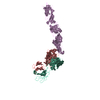 3i50C  3ixxC M: map data used to model this data C: citing same article ( |
|---|---|
| Similar structure data |
- Links
Links
- Assembly
Assembly
| Deposited unit | 
|
|---|---|
| 1 | x 60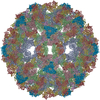
|
| 2 |
|
| 3 | x 5
|
| 4 | x 6
|
| 5 | 
|
| Symmetry | Point symmetry: (Schoenflies symbol : I (icosahedral : I (icosahedral )) )) |
- Components
Components
| #1: Protein |  / Coordinate model: Cα atoms only / Coordinate model: Cα atoms onlyMass: 43904.410 Da / Num. of mol.: 3 Source method: isolated from a genetically manipulated source Source: (gene. exp.)   Dengue virus 2 / Strain: DENV2 / Cell line (production host): C6/36 / Production host: Dengue virus 2 / Strain: DENV2 / Cell line (production host): C6/36 / Production host:   Aedes albopictus (Asian tiger mosquito) / References: UniProt: O11875, UniProt: Q9WDA6*PLUS Aedes albopictus (Asian tiger mosquito) / References: UniProt: O11875, UniProt: Q9WDA6*PLUS#2: Protein | Mass: 9261.531 Da / Num. of mol.: 3 Source method: isolated from a genetically manipulated source Source: (gene. exp.)   Dengue virus 2 / Strain: DENV2 / Cell line (production host): C6/36 / Production host: Dengue virus 2 / Strain: DENV2 / Cell line (production host): C6/36 / Production host:   Aedes albopictus (Asian tiger mosquito) / References: UniProt: P18356 Aedes albopictus (Asian tiger mosquito) / References: UniProt: P18356#3: Antibody | Mass: 23630.504 Da / Num. of mol.: 2 Source method: isolated from a genetically manipulated source Source: (gene. exp.)   Mus musculus (house mouse) / Production host: Mus musculus (house mouse) / Production host:   Escherichia coli (E. coli) / Strain (production host): DE3 Escherichia coli (E. coli) / Strain (production host): DE3#4: Antibody | Mass: 23588.107 Da / Num. of mol.: 2 Source method: isolated from a genetically manipulated source Source: (gene. exp.)   Mus musculus (house mouse) / Production host: Mus musculus (house mouse) / Production host:   Escherichia coli (E. coli) / Strain (production host): DE3 Escherichia coli (E. coli) / Strain (production host): DE3 |
|---|
-Experimental details
-Experiment
| Experiment | Method:  ELECTRON MICROSCOPY ELECTRON MICROSCOPY |
|---|---|
| EM experiment | Aggregation state: PARTICLE / 3D reconstruction method:  single particle reconstruction single particle reconstruction |
- Sample preparation
Sample preparation
| Component | Name: Immature Dengue Virus complexed with E53 Fab / Type: VIRUS Details: T1 icosahedron with three E monomers and two Fab per asymmetric unit |
|---|---|
| Molecular weight | Value: 24.4 MDa / Experimental value: NO |
| Details of virus | Empty: NO / Enveloped: YES / Host category: VERTEBRATES / Isolate: STRAIN / Type: VIRION |
| Natural host | Organism: Homo sapiens |
| Buffer solution | pH: 7.6 / Details: 12 mM Tris-HCl, 120 mM NaCl, 1 mM EDTA |
| Specimen | Embedding applied: NO / Shadowing applied: NO / Staining applied : NO / Vitrification applied : NO / Vitrification applied : YES / Details: 12 mM Tris-HCl, 120 mM NaCl, 1 mM EDTA : YES / Details: 12 mM Tris-HCl, 120 mM NaCl, 1 mM EDTA |
Vitrification | Instrument: HOMEMADE PLUNGER / Cryogen name: ETHANE Method: A small vial of ethane is placed inside a larger liquid nitrogen reservoir. The grid holding a few microliters of the sample is held in place at the bottom of a plunger by the means of fine ...Method: A small vial of ethane is placed inside a larger liquid nitrogen reservoir. The grid holding a few microliters of the sample is held in place at the bottom of a plunger by the means of fine tweezers. Once the ethane in the vial is completely frozen, it needs to be slightly melted. When the liquid ethane is ready, a piece of filter paper is then pressed against the sample to blot of excess buffer, sufficient to leave a thin layer on the grid. After a predetermined time, the filter paper is removed, and the plunger is allowed to drop into the liquid ethane. Once the grid enters the liquid ethane, the sample is rapidly frozen, and the grid is transferred under liquid nitrogen to a storage box immersed liquid nitrogen for later use in the microscope. |
- Electron microscopy imaging
Electron microscopy imaging
| Microscopy | Model: FEI/PHILIPS CM300FEG/T / Date: Apr 4, 2008 / Details: low dose |
|---|---|
| Electron gun | Electron source : :  FIELD EMISSION GUN / Accelerating voltage: 300 kV / Illumination mode: FLOOD BEAM / Electron beam tilt params: 0 FIELD EMISSION GUN / Accelerating voltage: 300 kV / Illumination mode: FLOOD BEAM / Electron beam tilt params: 0 |
| Electron lens | Mode: BRIGHT FIELD Bright-field microscopy / Nominal magnification: 45000 X / Calibrated magnification: 47244 X / Nominal defocus max: 2728 nm / Nominal defocus min: 1876 nm / Cs Bright-field microscopy / Nominal magnification: 45000 X / Calibrated magnification: 47244 X / Nominal defocus max: 2728 nm / Nominal defocus min: 1876 nm / Cs : 2 mm / Astigmatism : 2 mm / Astigmatism : live FFT / Camera length: 0 mm : live FFT / Camera length: 0 mm |
| Specimen holder | Specimen holder model: GATAN LIQUID NITROGEN / Specimen holder type: EUCENTRIC / Temperature: 98 K / Tilt angle max: -9999 ° / Tilt angle min: -9999 ° |
| Image recording | Electron dose: 15 e/Å2 / Film or detector model: KODAK SO-163 FILM |
| Radiation | Protocol: SINGLE WAVELENGTH / Monochromatic (M) / Laue (L): M / Scattering type: x-ray |
| Radiation wavelength | Relative weight: 1 |
- Processing
Processing
| EM software |
| |||||||||||||||||||||
|---|---|---|---|---|---|---|---|---|---|---|---|---|---|---|---|---|---|---|---|---|---|---|
CTF correction | Details: Each particle | |||||||||||||||||||||
| Symmetry | Point symmetry : I (icosahedral : I (icosahedral ) ) | |||||||||||||||||||||
3D reconstruction | Resolution: 23 Å / Resolution method: FSC 0.5 CUT-OFF / Num. of particles: 2741 / Actual pixel size: 2.69 Å / Magnification calibration: 47244 Details: ( Details about the particle: 400 mesh copper grid ) Symmetry type: POINT | |||||||||||||||||||||
| Atomic model building |
| |||||||||||||||||||||
| Atomic model building |
| |||||||||||||||||||||
| Refinement step | Cycle: LAST
|
 Movie
Movie Controller
Controller


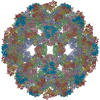
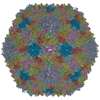


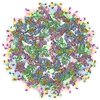

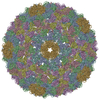

 PDBj
PDBj



